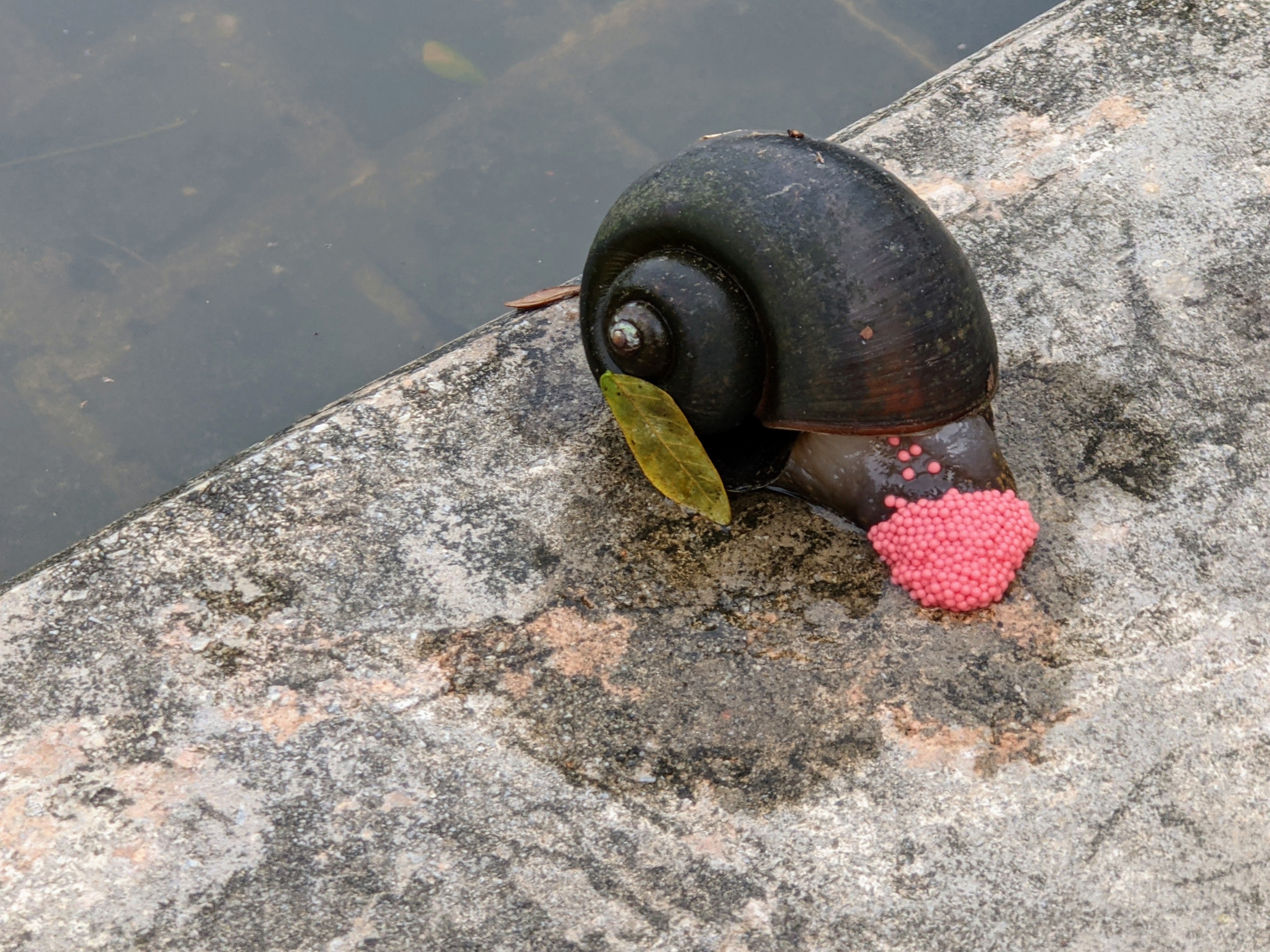Giant apple snail confirmed in Arkansas; look, scout, but don’t touch
Giant apple snails are prolific. They laying bright pink masses of 1,500 to 2,000 eggs each every five to 14 days.
By Mary Hightower
U of Arkansas System Division of Agriculture
April 15, 2024
Fast facts:
- Giant snails first reported in Florida in 1980s
- Snails considered a serious pest of rice in certain production systems
(620 words)
(Newsrooms: with file art)
LONOKE, Ark. — The giant apple snail, considered a serious pest in rice in other countries, has been confirmed in Arkansas, the nation’s top rice-growing state.
Last Tuesday, the Arkansas Game and Fish Commission confirmed the presence of the large South American snails in Arkansas, which were likely brought to the state in a load of crawfish.
The giant apple snail is typically 2-4 inches tall and can reach up to 6 inches. They are prolific, laying bright pink masses of 1,500 to 2,000 eggs each every five to 14 days. The snails were first seen in Florida in the 1980s and now have wild populations in Alabama, Arizona, Louisiana, Mississippi, North Carolina, South Carolina and Texas.

The snails have been known to feed on rice plants in flooded fields in Louisiana and Texas and are considered to be major pests of rice in Spain, Southeast Asia, the Philippines and Central America, according to Louisiana State University.
Louisiana Fish and Wildlife said the big snails might cause other headaches by blocking drainage and irrigation pipes.
According to LSU, rice and crawfish farmers started reporting high populations of apple snails in their ponds in 2018.
“So far, their damage to U.S. rice has been minimal,” LSU said. “The widespread adoption of drill-seeding rice and applying the permanent flood approximately five weeks after planting seems to have mitigated the impact of snails in Texas rice.”
Nick Bateman, extension entomologist for the University of Arkansas System Division of Agriculture, said on Thursday that in Arkansas’ “production system, the snails shouldn’t be a major concern since we don’t no-till many acres of rice or do much water seeding. Those are the areas that are going to be affected the most by this pest.”
That’s a plus, because “there are no real treatments for apple snails either. In other crops, Deadline® M-Ps is the only good option for slugs and snails and it needs to be dry for an extended time to get effective control since it's a bait. It's also not labeled for use in rice.”
Bateman said that research from LSU shows copper sulfate has some efficacy along with straight crop oil, which works as a surfactant.
“Right now, I think we tell folks to keep an eye out and scout for them,” Bateman said. “We will get data here as soon as there is a chance. It has also taken a long time for them to make much of an impact in Louisiana and it's mainly their water-seeded rice.”
Fortunately, giant apple snails have not yet been found in the wild in Arkansas. The AGFC has worked with the state of Louisiana to prevent the spread of this invasive species through many potential pathways of introduction, including aquarium pet releases. AFGC has also worked on educational campaigns about cleaning boats and recreational equipment to prevent the spread of the mollusks.
Additional vigilance by Arkansans through inspections of any live crawfish shipments, no matter the source will help prevent further spread of this invasive species that could affect native wildlife and Arkansas’ rice industry.
The Arkansas Game and Fish Commission said the snails can also pose a health hazard.
“In addition to being an agricultural pest and damaging aquatic ecosystems, these snails can also threaten human health,” the commission said. “Apple snails are known to carry rat lungworm, a parasite that can infect mammals, including humans, through the consumption of uncooked snail meat or contaminated produce.
“People with mild infections usually recover fully, but severe infections of the parasite can cause eosinophilic meningitis,” the commission said. “Additionally, the snail’s eggs contain a neurotoxin that can cause skin and eye irritation if handled.”
Mention of product names does not imply endorsement by the University of Arkansas System Division of Agriculture.
To learn about extension programs in Arkansas, contact your local Cooperative Extension Service agent or visit www.uaex.uada.edu. Follow us on X and Instagram at @AR_Extension. To learn more about Division of Agriculture research, visit the Arkansas Agricultural Experiment Station website: https://aaes.uada.edu. Follow on X at @ArkAgResearch. To learn more about the Division of Agriculture, visit https://uada.edu/. Follow us on X at @AgInArk.
About the Division of Agriculture
The University of Arkansas System Division of Agriculture’s mission is to strengthen agriculture, communities, and families by connecting trusted research to the adoption of best practices. Through the Agricultural Experiment Station and the Cooperative Extension Service, the Division of Agriculture conducts research and extension work within the nation’s historic land grant education system.
The Division of Agriculture is one of 20 entities within the University of Arkansas System. It has offices in all 75 counties in Arkansas and faculty on five system campuses.
Pursuant to 7 CFR § 15.3, the University of Arkansas System Division of Agriculture offers all its Extension and Research programs and services (including employment) without regard to race, color, sex, national origin, religion, age, disability, marital or veteran status, genetic information, sexual preference, pregnancy or any other legally protected status, and is an equal opportunity institution.
# # #
Media contact: Mary Hightower
mhightower@uada.edu